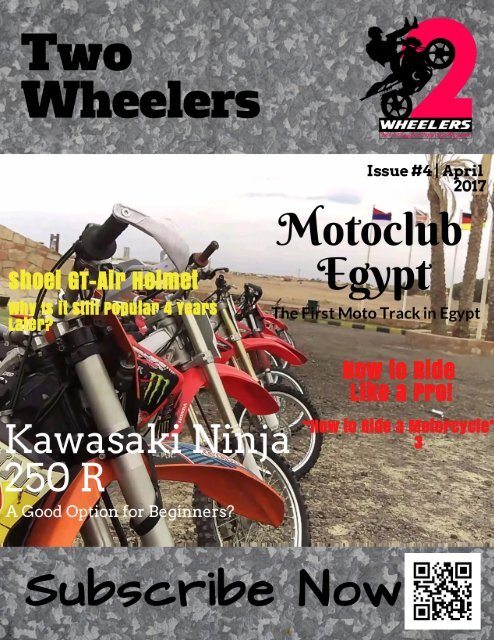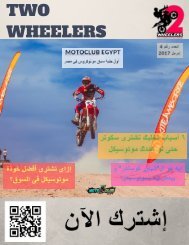Two Wheelers Magazine- Issue #4 - April 2017
Two Wheelers is the first Egyptian motorcycle magazine that brings the latest updates to all two-wheelers enthusiasts around the world. The latest bikes on the market, bikes’ upgrades, entertainment aspects related to bikers and much more. Our audience is the most important stakeholder. Therefore, we are eager to provide them with informative articles (fun ones too) to add value and keep them entertained. We make sure to maintain consistency in delivering rich content to our beloved readers. Two-Wheelers team is welcoming bikers from all around and is wishing you safe riding accompanied by adrenaline rushes.
Two Wheelers is the first Egyptian motorcycle magazine that brings the latest updates to all two-wheelers enthusiasts around the world. The latest bikes on the market, bikes’ upgrades, entertainment aspects related to bikers and much more. Our audience is the most important stakeholder. Therefore, we are eager to provide them with informative articles (fun ones too) to add value and keep them entertained. We make sure to maintain consistency in delivering rich content to our beloved readers. Two-Wheelers team is welcoming bikers from all around and is wishing you safe riding accompanied by adrenaline rushes.
You also want an ePaper? Increase the reach of your titles
YUMPU automatically turns print PDFs into web optimized ePapers that Google loves.
MOTOCLUB<br />
EGYPT<br />
Hundreds of holidays to El Gouna are<br />
booked every day, yet a new hotspot<br />
(Motoclub Egypt) is added to the list of<br />
activities that grabbed our attention as a<br />
motorcycle-related magazine; a new moto<br />
track (actually the first of its kind in Egypt)<br />
was organizing its first official motocross<br />
racing competition.<br />
We were invited to this memorable event<br />
and here is what we found out…<br />
The Moto Track.<br />
Well, for starters, there are two motocross<br />
tracks; a beginners’ one (an outside track)<br />
that consists of smooth curves (approx.<br />
1200m) and an inner intermediate one<br />
with sharper curves and tougher ramps<br />
(approx. 1800m).<br />
The staff offers you the protective gear,<br />
the bike and some useful tips & tricks in<br />
case you are a beginner for a fair price.<br />
Also, you are welcomed to just squeeze<br />
the throttle and hit the dirt in case you<br />
have your own stuff.<br />
The Club.<br />
The club has a spectacular view;, especially<br />
during sunsets. There may be a couple of<br />
blind spots from up there, however, most<br />
of the time you can clearly see the racers<br />
having fun on the moto track.<br />
The club serves a wide variety of snacks<br />
and drinks in case you needed a refuel<br />
during your breaks (definitely needed it<br />
with the adrenaline rush you will be<br />
experiencing). Moreover, it’s a really good<br />
spot for the general audience who are<br />
looking forward to chilling with a perfect<br />
view.<br />
Their First Official Racing Competition.<br />
If you spend your holidays at El Gouna,<br />
then you are perfectly aware of the fact<br />
that nowadays are considered to be the<br />
peak of the season. On the other hand,<br />
there was an extraordinary buzz at this<br />
charming place, and it all came from the<br />
Motoclub.<br />
The Moto Track was organizing its first<br />
official motocross & ATV racing<br />
competition. Both national & international<br />
racers competed head to head in a time<br />
attack race along with some fine beats<br />
produced by the DJ and mixed with the<br />
cheers of the audience.<br />
There were three main categories; 450s,<br />
250s and the ATV. The racers were<br />
divided among two main groups, each had<br />
to race for 20 laps (10 laps followed by a<br />
break each). Racers received their briefing<br />
for the moto track and were introduced to<br />
the rules and flags before starting.<br />
T W O W H E E L E R S | P A G E 3
Several publishing houses, magazines, and<br />
sponsors were present during the event.<br />
Red Bull, Sliders, Moods, Masrawy,<br />
Orascom & El Gouna were the main<br />
figures along with many others.<br />
The event ended with a memorable<br />
ceremony for the top three winners in<br />
each category where cups, medals, and<br />
gifts (complimentary services offered by<br />
the sponsors) were distributed on the<br />
podium.<br />
We’ll take you in a tour in this video (there<br />
is a message from the track owner too).<br />
Our Final Call.<br />
Well, we can assure you that it was a blast.<br />
The race went pretty good (with minimal<br />
casualties), it was very well organized<br />
(marshals were doing their job) and all of<br />
the safety precautions & measures were<br />
taken (medics on track,…etc).<br />
Also, the timing was recorded both<br />
manually and through time stamps (videos<br />
on track) to achieve the highest level of<br />
accuracy.<br />
The entertainment included a DJ<br />
throughout the whole day (from 2 till 7<br />
pm) and free drinks. Not to mention the<br />
availability of ordering snacks (a la carte).<br />
All in all, we were really pleased to attend<br />
this competition and we are really looking<br />
forward to seeing more competitions<br />
being held at this breathtaking venue.<br />
R E I S E | P A G E 4
SHOEI GT-AIR<br />
HELMET; WHY IS IT<br />
STILL POPULAR 4<br />
YEARS LATER?<br />
The Shoei GT-Air Helmet was released in<br />
2013. Even though it has been nearly 4<br />
years since its release date, yet it’s<br />
considered to be one of the most popular<br />
premium helmets.<br />
There’s no room for questioning the<br />
credibility of Shoei as a motorcycle helmet<br />
brand. But, is goodwill the only reason<br />
behind this model’s sustainability?<br />
We decided to take you through a quick<br />
review of the Shoei GT-Air motorcycle<br />
helmet. Hopefully, by the end of this<br />
article, you shall decide yourself whether<br />
it deserves to be one of the top motorcycle<br />
helmets within its category.<br />
to the aerodynamics design; professional<br />
riders’ feedbacks were taken into<br />
consideration too.<br />
The Shoei GT-Air has a molded air spoiler<br />
that reduces the pressure on your neck in<br />
case you decided to go a little bit speedy<br />
(by a little bit we do mean insanely<br />
speeding ).<br />
The Ventilation.<br />
According to riders’ feedbacks, this helmet<br />
is one of the best options on the market<br />
when it comes to effective ventilation. The<br />
upper tunnel allows maximum volume of<br />
air flow and performance behind wind<br />
screens.<br />
Moreover, the lower air intake vent<br />
reduces defrosting and fogging. Rear<br />
exhaust vents work like a charm, leaving<br />
no chance for heat to build up.<br />
Shoei GT-Air Helmet Material.<br />
The Shoei GT-Air is engineered using an<br />
Advanced Integrated Matrix (AIM)<br />
system. In English, the manufacturer<br />
combined high-performance fiber<br />
materials with elastic organic fibers. As a<br />
result, the shell’s most significant features<br />
are rigidity and ultra light-weight.<br />
The Aerodynamics.<br />
The helmet was tested under extreme<br />
conditions in Shoei’s wind tunnel in Japan.<br />
Yet, the engineers didn’t totally rely on<br />
numbers and machines when it comes<br />
T W O W H E E L E R S | P A G E 5
The Interior.<br />
If you own a Shoei-GT Air helmet, then you<br />
have already experienced the luxury of its<br />
“salon”. A 3-D Max-Dry center pad, along<br />
with multi-layered polyurethane foam<br />
cheek pads (removable ones). The interior<br />
is Eyeglass compatible too.<br />
Another great future that many riders<br />
underestimate its importance (including<br />
you of course) is the Emergency Quick<br />
Release System (E.Q.R.S). We all<br />
experience bad days while riding and don’t<br />
expect all medics to be helmet experts<br />
when it comes to its removal.<br />
Why Popular 4 Years Later After<br />
Production?<br />
Our evaluation is as follows:<br />
– Great inner sun visor quality.<br />
– Excellent noise reduction feature.<br />
– Rigid and ultra-lightweight shell (3.67<br />
lbs).<br />
What Are the Downsides?<br />
Well, it’s only DOT certified. We can’t<br />
really tell why Shoei didn’t go for the rest.<br />
An Exceptional shoei gt air Sun Shield Visor.<br />
If you are searching for an internal sun<br />
visor with HD image resolution that will<br />
both protect you and provide a clear<br />
image. Then, search no more. A Built-in<br />
QSV-1 sun shield that meets the ANSI<br />
Z80.3-2010 standard for non-prescription<br />
glasses.<br />
Forget About the Lousy Noise.<br />
The Shoei GT Price.<br />
Mix the distinctive aerodynamics,<br />
ventilation and interior features that were<br />
previously mentioned. What do you get?<br />
An extremely quite Shoei-GT Air<br />
motorcycle helmet. Probably one of the<br />
quietest helmets you can ever have.<br />
The chin curtains and the Dual-Ridge<br />
window bead contribute significantly to<br />
the noise reduction feature.<br />
Well, according to our grading system<br />
($,$$,$$$), the Shoei GT helmet can take a<br />
$$$ (that’s an estimate at the time of<br />
publishing this article). Yes, it’s a little bit<br />
expensive. But, you can clearly tell the<br />
difference between a $200 and a Shoei<br />
Helmet.<br />
Hopefully, our review answered the<br />
mystery behind this model’s fame.<br />
T W O W H E E L E R S | P A G E 6
KAWASAKI NINJA<br />
250 R : A GOOD<br />
OPTION FOR<br />
BEGINNERS?<br />
The Kawasaki Ninja 250 R is considered to<br />
be one of the most lightweight and agile<br />
motorcycles on the market. Well,<br />
technically speaking, those features are<br />
common within this category (250cc) of<br />
most sport bikes.<br />
Power & weight control are crucial for<br />
beginners when it comes to riding;<br />
Leaning, cornering, and accelerating<br />
should be done carefully if you are still<br />
new in the two wheels hobby.<br />
We decided to take you through a quick<br />
review on the Kawasaki Ninja 250 cc in<br />
case you are wondering whether it’s a<br />
reliable option (and a practical one).<br />
We would like to highlight the fact that the<br />
Kawasaki 250 motorcycle has been out of<br />
mass production in 2011, and replaced by<br />
the 300cc one in most countries. However,<br />
if you are planning on buying a 2nd hand<br />
motorcycle (as your first ride), you should<br />
definitely consider this option.<br />
Kawasaki’s 250 cc Engine.<br />
Remember the old ZZ-R/GPX 250 engine?<br />
Well, it’s kind of the same one loaded in<br />
the Ninja 250 R. Yet, it’s more<br />
environmentally friendly and more<br />
advanced. The Engine will provide you<br />
with 33 Horsepower and 22 NM Torque.<br />
As you can clearly see, the engine power is<br />
low which makes it perfect for beginners<br />
who won’t feel the throttle power (either<br />
during acceleration or deceleration).<br />
The Kawasaki Ninja 250 R has a liquid<br />
cooling system, 249 cc, DOHC and 2<br />
parallel twin cylinders. The Top Speed<br />
recorded for this motorcycle was<br />
approximately 150Km/Hr.<br />
Since you chose a sports bike, we do<br />
realize that you are most probably an<br />
adrenaline-junkie (aren’t we all are?).<br />
However, it’s better to take baby steps<br />
when it comes to speed and engine power.<br />
Dimensions & Weight.<br />
That’s the second most important thing to<br />
take into consideration if you are a<br />
beginner. With the Ninja 250 R, we are<br />
talking about an overall length of<br />
2085mm, a width of 715mm and, a height<br />
of 1115 mm.<br />
As for the weight, the 250 motorcycle<br />
weighs 165 Kgs. Not a lot of weight<br />
reduction compared to the latest<br />
superbikes models. However, you have to<br />
keep in mind the difference in materials<br />
that are used in both motorcycles for<br />
weight reduction purposes.<br />
The lightweight feature might be common<br />
among the latest models and the 250 R<br />
Ninja. However, you have to keep in mind<br />
the difference in power (which is kind of a<br />
very big deal by the way).<br />
T W O W H E E L E R S | P A G E 7
Last but not least, the Kawasaki 250 cc motorcycle has narrow tires; this gives it a higher<br />
maneuvering ability (and an easier one which is ideal for beginners), even though it comes with the<br />
cost of a lower stability.<br />
Kawasaki 250cc Price.<br />
The Ninja 250 R has a price range of $2300 to $4000. In other words, you won’t be facing any<br />
troubles in financing your very first motorcycle.<br />
Our Final Call.<br />
Even though the Kawasaki 250 R has been on the market for only 4 years (2008-2011), yet it<br />
managed to leave a remarkable positive print within its category as an option for beginner<br />
motorcyclists. If you want to get the whole specs in numbers CLICK HERE<br />
T W O W H E E L E R S | P A G E 8
HOW TO RIDE<br />
LIKE A PRO! “HOW<br />
TO RIDE A<br />
MOTORCYCLE”<br />
PART 3.<br />
We are pretty sure that you have spent<br />
some time riding by now and there first<br />
thing that is going to cross your mind is It’s<br />
time to ride like a pro!. Therefore, we<br />
decided to release the 3rd (and last part)<br />
of the “How to ride a motorcycle” guide in<br />
order to share with you some useful safety<br />
tips to achieve that.<br />
The most common things that professional<br />
riders do (and you will probably air for) are<br />
the wheelies, cornering, and hitting highspeed<br />
milestones. Here in this guide, we<br />
will take you through some tips that you<br />
need to follow if you are planning on not<br />
ending up in the hospital.<br />
Ride Like a Pro while Performing Wheelies.<br />
The moment you master riding on two<br />
wheels, the first thing that crosses your<br />
mind is driving on a single one (the rear<br />
one for starters). Whether you are looking<br />
forward to impressing other folks by<br />
showing off your skills or you just enjoy<br />
the adrenaline rush, you should keep the<br />
following in mind.<br />
Power Wheelies or Clutch Ones?<br />
There are two main ways to pop off your<br />
front wheel riding. The first is by simply<br />
squeezing the throttle hard enough to<br />
“take off”.<br />
Even though this method is way easier<br />
than using the clutch, however, it’s more<br />
aggressive and gives the rider instant<br />
power.<br />
It’s recommended to study your<br />
motorcycle power and your weight<br />
thoroughly before going for the power<br />
wheelies. Usually, motorcycles with more<br />
powerful engines and high torque can<br />
perform that type of wheelies.<br />
On the other hand, clutch wheelies are<br />
relatively safer. You get more control<br />
during the “take off” over your bike and<br />
somehow can limit the pop off the height<br />
of the front wheel. You simply hold down<br />
the clutch while riding, squeeze the<br />
throttle a little, pop off the clutch and<br />
squeeze the throttle more (voila your<br />
front wheel is in the sky).<br />
Keep in mind that the previously<br />
mentioned steps should take place in a<br />
matter of milliseconds. Don’t push it too<br />
far with the clutch to keep your<br />
motorcycle engine running smoothly.<br />
Both wheelies need squeezing the throttle<br />
while riding at the correct gear and RPM.<br />
There isn’t a specific rule (gear or RPM<br />
number) where you should pop your<br />
people, as motorcycles and riders’ features<br />
are different. Yet, avoid popping the<br />
wheelie with low gear/high RPM (you will<br />
probably flip over) and a high gear/ Low<br />
RPM won’t make the wheel pop (unless<br />
you are that good!).<br />
T W O W H E E L E R S | P A G E 9
The “Take Off”.<br />
If you are planning to ride like a pro, then<br />
you need to know your limits. While<br />
popping a wheelie there is a balance point<br />
that you should never overcome while<br />
lifting your nose. This is the point where<br />
you will either flip back or will keep things<br />
balanced.<br />
It’s interesting to say that some Pro bikers<br />
are able to cross the balance point while<br />
raising the nose (sometimes hitting the 90<br />
degrees) and succeed in making their way<br />
down with a smooth landing. Yet, if you<br />
are not willing to join the stunt<br />
championship we recommend keeping it<br />
below the balance point.<br />
The “Landing”.<br />
This is the part that differentiates the<br />
amateurs from others who ride like a pro;<br />
nearly everyone can life their front wheel,<br />
but not everyone can land it smoothly and<br />
safely. Again depending on your<br />
motorcycle weight (and yours of course)<br />
you should give your babe a little speed<br />
while landing.<br />
Removing your hand off the throttle<br />
suddenly and leaving your motorcycle to<br />
land under its own weight will probably<br />
lead to an unfortunate crash. If you are<br />
lucky enough to overcome the crash than<br />
you are literally torturing your front<br />
motorcycle suspension.<br />
Treat your babe nicely my friend. Give<br />
your motorcycle a little throttle squeeze<br />
while landing to keep things smooth and<br />
safe!<br />
Moving on to the next Pro Biker’s move,<br />
the cornering.<br />
T W O W H E E L E R S | P A G E 1 0
Similarly, as the wheelies, there are two types of cornering, depending on your motorcycle riding<br />
style. You can either go under your bike while leaning (Sup racers and street fighters?!) or you can<br />
stay still and lean your motorcycle itself (depend on more on the counter steering).<br />
The leaning under your motorcycle style while allow you to corner at high speeds. This method<br />
screams “I can ride like a pro”! On the other hand, it’s more dangerous since you’re literally<br />
grabbing knees to the road and almost of your motorcycle.<br />
What should I do to make this safer?<br />
First of all, make sure you are approaching the curve with the right speed. Excessive speed will<br />
make you go off track (or outside the cornering imaginary line that you are following) and low<br />
speed will make you simply fall off your motorcycle (and look like a complete jerk!).<br />
A Pro biker will enter the curve with an imaginary drawn line for cornering to follow and the<br />
correct speed. But, since unexpected situations may happen, you may need to brake while<br />
cornering or follow another cornering line while leaning.<br />
In that case, make sure to use both brakes (front and rear) slightly to reach the desired speed or<br />
avoid a crash. Keep the balance while pressing the brakes as hard rear braking will result in<br />
skidding and front ones may result in an unpleasant rollover.<br />
If you ride like a pro then we are pretty sure that you have also heard about accelerating<br />
(rationally) while going out of the curve to increase the grip and handling.<br />
Don’t Chicken Out!<br />
We do understand the fear of getting close to the ground (and under your motorcycle) at high<br />
speeds while cornering. Yet, if you do chicken out while doing so, there’s a 200% possibility to<br />
crash at the corner.<br />
Make sure to be in the right position while leaning and nothing will go wrong (we hope so). Both<br />
feet tips are on the foot pegs, the inner knee (and elbow) is pointed outside towards the road<br />
(hopefully looking forward to spark) and the other is pushed tight against the motorcycle tank.<br />
Also, you should place your hips a little off the seat towards the corner and ALWAYS look to<br />
where you want to go (following the imaginary line) and not through the motorcycle visor. Your<br />
helmet should be near the side mirror totally outside the motorcycle itself.<br />
T W O W H E E L E R S | P A G E 1 1
How to Ride like a Pro on High Speeds.<br />
You want to get the adrenaline rush of the<br />
high speed, we get it. But, you need to do it<br />
as safely as possible. Every Pro biker<br />
crash, that’s a fact. Yet, crashing at high<br />
speeds is usually fatal. That’s why you<br />
need to memorize the following tips by<br />
heart .<br />
Know Your Motorcycle Limit!<br />
It’s weight, braking power, maneuvering<br />
agility, top speed and many others. Yes, it’s<br />
really cool trying to intimidate an online<br />
video for a Kawasaki H2 (click here to<br />
check it) hitting the 400 KM/Hr. But you<br />
shouldn’t try to aim for that with your 600<br />
cc motorcycle. If you are planning to go full<br />
speed, be rational while doing so.<br />
You can reach a point where your visibility<br />
will be nothing but a small clear focal point<br />
and the rest of the road is totally blurred<br />
due to high speed. Always keep those two<br />
factors in mind while riding at high speeds.<br />
Maintenance Check!<br />
Before going on a full speed ride, always<br />
check your motorcycle. The brakes,<br />
suspension, tires, fairings, the engines,<br />
…etc. If you are willing to ride at high<br />
speeds, then you better make sure that<br />
your babe is in its prime condition.<br />
Yes, we know what you’re thinking about<br />
right now, we missed talking about the<br />
Stoppies. No, we didn’t we just decided to<br />
talk about this one separately as it needs<br />
getting into more details, and it needs<br />
some very special skills.<br />
Draw Multiple Exit Scenarios.<br />
Assess each and every vehicle while<br />
overtaking it. Draw multiple exit scenarios<br />
for unexpected situations and make sure<br />
you have the time to perform your<br />
maneuver. If a driver changed lanes<br />
suddenly without using the turn signals,<br />
it’s his fault, but you’re the one who is<br />
going to pay for it.<br />
Response Time and Visibility.<br />
Your response time (for breaking and<br />
maneuvering) will be lowered the higher<br />
your speed is. Identifying the threat,<br />
deciding to break (or maneuver), then<br />
taking an action while you are riding at 60<br />
KM/ Hr is not the same at 200 KM/Hr.<br />
Hopefully, this article was beneficial and<br />
we wish that it added value. The <strong>Two</strong><br />
<strong>Wheelers</strong> Team always encourages its<br />
readers to follow their local traffic laws, to<br />
ride safely and enjoy their rides!<br />
T W O W H E E L E R S | P A G E 1 2
"HERE'S TO THE<br />
WOMEN WHO HEAR<br />
THE SONG OF<br />
UNBRILLED<br />
FREEDOM, AND<br />
WHOSE HEARTS<br />
LIGHTS THE FIRES OF<br />
INSPIRATION FOR<br />
OTHER WOMEN"<br />
B E T H<br />
T W O W H E E L E R S | P A G E 1 3











